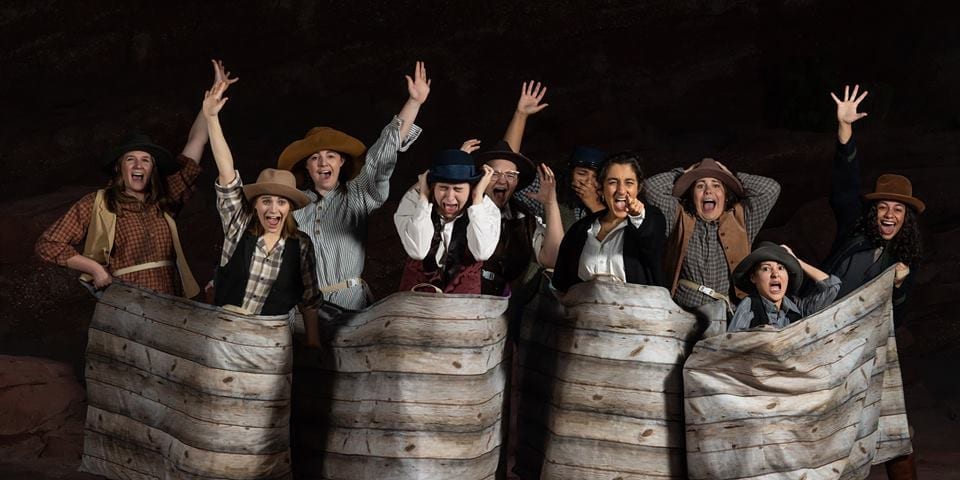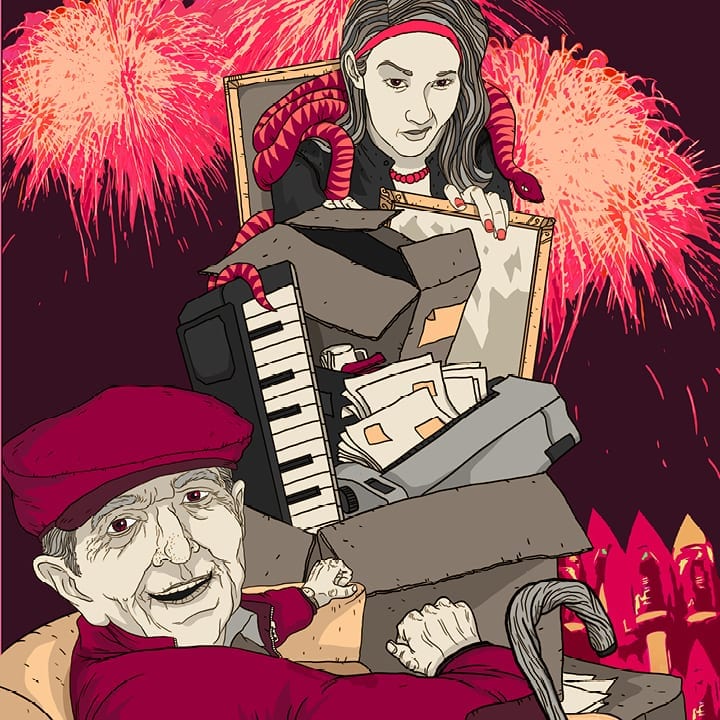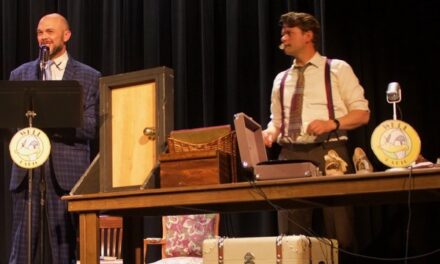SALT LAKE CITY — Men on Boats is a rollicking retelling of John Wesley Powell’s ten-man, 1869 expedition to map the Grand Canyon. It includes action, adventure, scrapes with death, humor and moments of high drama surrounding the men’s journey down river. The ensemble and crew of Westminster College’s production take on the challenges of the play with great aplomb and, after some warming up, success.

Show closes October 13, 2018.
It’s important to note that playwright Jaclyn Backhaus insists in her script that all ten acting roles be performed by “radically diverse actors who are female identifying.” Action/Adventure roles without a hint of romance or servitude are hard to come by for female actors, and especially racially and physically-abled diverse actors. Backhaus’s script provides and all too rare opportunity for all out physicality and quirkiness for an all-female cast.
The script is fascinating and provides fully-fledged characterization for each of the adventurers. Each is a realization of a time-tested western trope. The leader, John Powell (played by Mina Sadoon), is the classic steely-eyed retired civil war general, but Powell’s insecurities about everything from his physical deficiencies to his doubts about how to lead the group are also apparent. Powell’s older brother, Old Shady (played by Melissa Salguero), is the slightly crazed loner, but the audience also gets to see Shady’s love for his brother and his penchant for making up morbid ditties. Other stereotypes are also explored and expanded on including the naïve kid (played by Lavinia Adams), the stubborn second-in-command (played by Mauri Althea Hefley), the surly but loving cook (played by Megan Sparrer) and many more—all fleshed out with distinct qualities and memorable moments.
 Roya Hedlund’s scenic design of rising red-rock canyon walls is dazzling and very efficient for the action, and it sparkles under the heavy saturation of light design by Spencer Brown. Lights and sound go hand-in-hand with the lovely Bluegrass selections that augment the action. However, Sam Allen’s rich sound design, including roaring rivers and ambient animal noise, felt jarring in the performance because of either a lack of fader switches or sound board operator skill.
Roya Hedlund’s scenic design of rising red-rock canyon walls is dazzling and very efficient for the action, and it sparkles under the heavy saturation of light design by Spencer Brown. Lights and sound go hand-in-hand with the lovely Bluegrass selections that augment the action. However, Sam Allen’s rich sound design, including roaring rivers and ambient animal noise, felt jarring in the performance because of either a lack of fader switches or sound board operator skill.
The prop design also called attention to a larger challenge in the production, and some elements of the production left me scratching my head. The titular boats were cleverly designed fabric panels that the actors held up or tied to their bodies during the frequent river running scenes. However, the actors seemed occasionally preoccupied by keeping a handle on their boats, and I found myself distracted when the boats were regularly rolled up or dropped to the floor like blankets. Even more confusing were the much-discussed food props like fish, apples and whiskey, which were sometimes present, but two-dimensional and oddly sized, and other times strictly pantomimed. This imbalance led to frequently rushed or non-realistic actor pantomimes of eating and drinking. I found myself wishing that a clearer choice had been made to either have all props boats, be either pantomimed or fully-realized for the sake of consistency.
There were similar inconsistencies in the emotional dimension of the performances that director Mark Fossen pulled out of the actors. In moments of strong emotion it was easy to follow the actors’ intentions, but in some of the script’s quieter or drawn-out moments I was unsure what the actors were intending to convey. This lack of emotional clarity was further hampered by some lack of vocal power. I found myself straining to hear and understand the actors from time to time, particularly in the first thirty minutes where I was already struggling to keep straight each of the ten characters.
On the other hand, the actors do a marvelous job of providing energy to the many cacophonous moments of sorrow, enthusiasm, outrage or joy as the performance rolls along. It is unclear if those first thirty minutes were the actors warming up, or my own ears adjusting to the script’s particular cadence and surprisingly modern vernacular. The way the contemporary script counterposes the historically accurate costumes (designed by Spencer Potter and Victoria Bird) is reminiscent of Hamilton and has a similar jarring (but purposeful) impact in bringing the 150-year-old characters into the modern world, allowing the audience to reflect on themselves and their own relationships.





